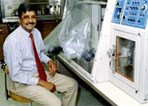Kansas State professor develops vaccine against liver abscess in cattle

Promises lower antibiotic use, lower feed costs, fewer condemned cow livers
Beef producers may soon bid farewell to antibiotics they now use to prevent liver abscess in cattle. A vaccine under development for the past 12 years at Kansas State University (KSU; Manhattan, KS) is close to commercialization, according to its inventor. T. G. Nagaraja, professor of veterinary medicine. KSU and commercialization partner Schering-Plough hope the product will hit the market some time in 2002 or 2003. Benefits of a liver abscess vaccine include lower cost than antibiotics, safer meat products, and more efficient reduction of liver abscess.
We've heard about the expense and timelines for new drugs, but 15 years for an animal vaccine?
"Our original partner for this drug was Mallinkrodt, which as you know was acquired by Schering-Plough," Nagaraja told Drug Discovery Online. "We lost at least a year while the corporate infrastructure was settling. The Schering Division handling this product also went through several other management changes, which took more time. Plus we're still looking for the ideal adjuvant to use with this vaccine."
 Liver abscess in cattle is caused by Fusobacterium necrophorum, a beneficial, symbiotic organism that normally resides in the rumen of cows. Sometimes conditions become favorable for the microorganism to escape the rumen, which it does through the portal vein. When it takes up residence in the liver, F. necrophorum results in abscesses that cause the liver to be unusable for food.
Liver abscess in cattle is caused by Fusobacterium necrophorum, a beneficial, symbiotic organism that normally resides in the rumen of cows. Sometimes conditions become favorable for the microorganism to escape the rumen, which it does through the portal vein. When it takes up residence in the liver, F. necrophorum results in abscesses that cause the liver to be unusable for food.
"Right now our efficacy in preventing liver abscess is about the same as antibiotics', around 40 to 50%," Nagaraja explained. "We think the problem is with the adjuvant. If we optimize that component of the vaccine, we think we can get much higher protection against abscess—perhaps close to 100%. Schering is now conducting efficacy studies on a number of adjuvants. We hope these studies will be completed within a year and a half."
 The stakes for an abscess vaccine are high, as public concern mounts regarding animal feed antibiotics. "There is increasing concern that the long-term use of antibiotics can lead to development of resistance in bacteria," Nagaraja said. "Therefore, development of a vaccine would be an ideal method of control."
The stakes for an abscess vaccine are high, as public concern mounts regarding animal feed antibiotics. "There is increasing concern that the long-term use of antibiotics can lead to development of resistance in bacteria," Nagaraja said. "Therefore, development of a vaccine would be an ideal method of control."
Nagaraja said cattle could receive the vaccine when they got other shots and that the vaccine's cost would be equal or less than the cost of antibiotics. Keeping the cost low is important because there is no way to tell externally if cattle have abscessed livers, so every cow must be vaccinated.
Liver abscess is a problem exclusively with feedlot cattle, which are fed high-grain diets to achieve rapid fattening before slaughter. Grain produces acid in the cow's stomach lining, and if damaged, bacteria can flow through the blood stream into the liver, where the bacteria will start to grow.
Nagaraja said beef producers will continue feeding cattle high-grain diets, as meat from grain-fed cattle is more tender and juicy compared to cattle fed primarily all-grass diets. Also, grain-fed beef is less expensive for consumers.
About 5 million livers are condemned each year because of liver abscess. With livers selling at an average of $5 each, five million condemned livers means a $15 to $20 million loss to the beef industry. And that is if only the liver is condemned. Often, abscessed livers require trimming, and occasionally abscesses rupture, causing the entire beef carcass to be condemned, contributing to a significant economic loss for the beef industry.
Nagaraja said economic loss occurs even before slaughter. Cattle with a liver abscess continue to eat high amounts of grain, but do not gain weight accordingly. Thus, a low feed conversion rate results in less income for beef producers.
Nagaraja said consumers should not worry about liver abscess because any liver with an abscess is condemned and not used for human consumption or pet food. "Even if the liver has a scar tissue where the abscess has healed, the liver is condemned," he said. "In terms of food safety there is no concern."
For more information: T. G. Nagaraja, Professor, Department of Diagnostic Medicine and Pathobiology, Kansas State University, 1800 Denison Ave., Manhattan, KS 66506-5606. Tel: 785-532-1214. Fax: 785-532-4851.
By Angelo DePalma
Managing Editor, Drug Discovery Online
